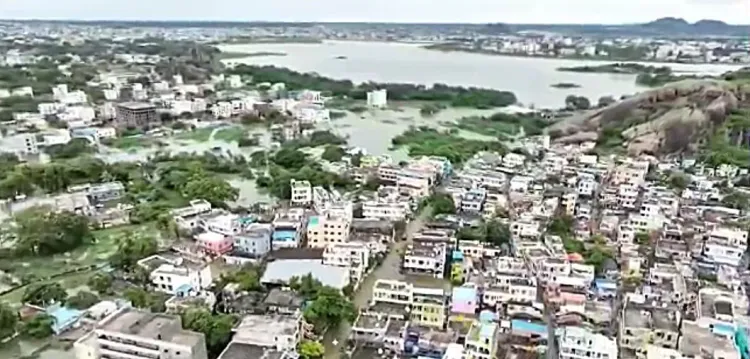What Caused the Recent Flash Floods in Telangana?

Synopsis
Key Takeaways
- Severe rainfall has led to flash floods in Telangana.
- Low-lying areas and roads have been significantly impacted.
- Authorities have lifted reservoir gates to manage water levels.
- Several districts have recorded heavy rainfall exceeding 11.50 cm.
- Flooding has disrupted coal production in the region.
Hyderabad, Aug 18 (NationPress) Severe rainfall has led to flash floods across multiple regions in Telangana, submerging low-lying areas and causing significant damage to roads and crops. Rivulets, streams, and lakes are overflowing as a result of relentless rains fueled by a low-pressure area in the Bay of Bengal.
With a surge of water from upstream, reservoirs reached maximum capacity, prompting officials to open gates to release water downstream.
Since Sunday, heavy rainfall has heavily impacted the united Medak district. Floodwaters from overflowing bodies disrupted road transport by damaging roads in several locations.
Near Pambanda in Shivampet mandal, roads were washed away, severing connectivity between Usirikapalli and Veldurthy. The route between Neelakantipalli and Alladurgam also faced similar destruction.
The renowned Edupayala Durga Bhavani temple in Medak district was submerged after water was discharged from the Singur project due to substantial inflows in Manjeera, a tributary of the Godavari River.
Flash floods have also led to extensive crop damage in the districts of Medak, Sangareddy, and Siddipet.
The Telangana Development Planning Society reported that Gouraram in Siddipet district recorded the highest rainfall of 23.58 cm in the past 24 hours ending at 5 A.M. on Monday, while Mulugu saw 18.63 cm and Islampur received 17.85 cm.
A total of 32 locations in Medak, Sangareddy, Siddipet, Kamareddy, Yadadri Bhuvanagiri, and Nizamabad districts experienced rainfall exceeding 11.50 cm.
Continuous rainfall over the past week has devastated crops across thousands of acres in various districts.
The united Adilabad district faced significant flooding due to heavy rains. A fisherman who went to the Kadam project has been reported missing, with authorities currently conducting searches using drones.
In the meantime, the water level in the Godavari has risen to 34.8 feet at Bhadrachalam in the Bhadradri Kothagudem district.
Additionally, heavy rains have disrupted coal production at the Singareni Collieries Company Limited (SCCL), impacting the extraction of 40,000 tonnes of coal due to flooding in the mines.
The IMD has predicted extremely heavy rainfall in isolated areas of Bhadradri Kothagudem district on Monday, issuing a red alert for this region as well as Mahabubabad and Mulugu districts.
Heavy to very heavy rainfall is anticipated in isolated locations throughout Jayashankar Bhupalpally district, while heavy rainfall is also expected in isolated areas of Adilabad, Hanumakonda, Kamareddy, Khammam, Komaram Bheem Asifabad, Mancherial, Medak, Nirmal, Sangareddy, Suryapet, Vikarabad, and Warangal districts.
Thunderstorms accompanied by lightning and gusty winds (30-40 kmph) are also likely across all districts in Telangana.









